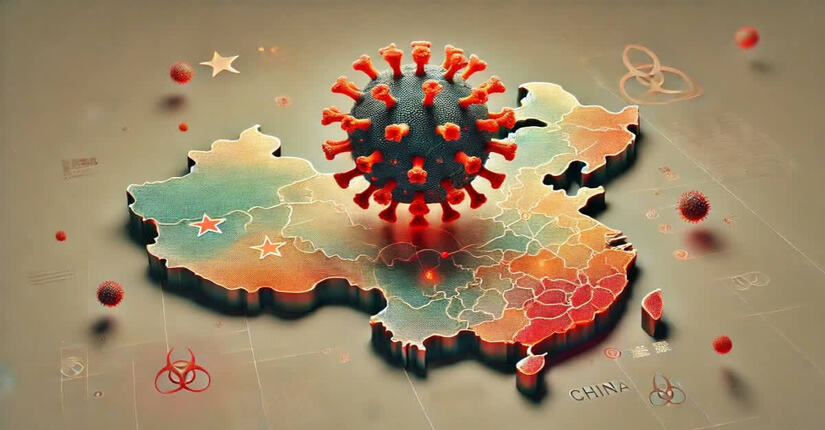China is witnessing a new health crisis with an outbreak of the human metapneumovirus (HMPV virus in China), just five years after the COVID-19 pandemic shook the world. The current situation has led to overcrowded hospitals and alarming social media reports. Here’s a comprehensive look at what HMPV is, its symptoms, complications, and tips for prevention.
What Is Human Metapneumovirus (HMPV)?
HMPV is a respiratory virus that primarily affects the upper respiratory system. Discovered in 2001, it is part of the Paramyxoviridae family, which also includes viruses causing measles and mumps. HMPV commonly spreads during the winter and early spring, presenting flu-like symptoms that range from mild to severe.
How Does It Spread?
HMPV spreads in ways similar to the common cold or flu. It transmits through:
- Respiratory droplets released during coughing or sneezing.
- Close personal contact, such as touching or shaking hands with an infected person.
- Touching surfaces contaminated with the virus and then touching your face.
Symptoms of HMPV virus in China
The symptoms of HMPV are often indistinguishable from those of the flu or a common cold. They usually appear within three to six days of exposure. Common symptoms include:
- Cough
- Fever
- Nasal congestion
- Sore throat
- Shortness of breath
In severe cases, HMPV can progress to complications that may require hospitalization.
High-Risk Groups: HMPV virus in China
While anyone can contract HMPV, certain groups are at a higher risk of severe illness:
- Young children: Their developing immune systems make them more vulnerable.
- Older adults: With age, immunity tends to weaken, increasing susceptibility.
- People with weakened immune systems: Individuals undergoing treatments like chemotherapy or those with chronic conditions like HIV are at greater risk.
- Those with pre-existing respiratory issues: Conditions like asthma or chronic obstructive pulmonary disease (COPD) may worsen.
Complications of HMPV
Although most cases of HMPV virus in China are mild, the virus can lead to serious complications, especially in vulnerable populations. These include:
- Bronchiolitis: Inflammation of the small airways in the lungs.
- Bronchitis: Inflammation of the larger airways.
- Pneumonia: Infection of the lungs.
- Asthma or COPD flare-ups: The virus can exacerbate pre-existing respiratory conditions.
- Ear Infections: Otitis media, especially in children.
Hospitalization may be required in severe cases to manage breathing difficulties or oxygen levels.
Preventive Measures for HMPV
Since there is no specific antiviral treatment or vaccine for HMPV virus in China, prevention is crucial. Here are some practical tips to reduce the risk of infection:
1. Practice Good Hand Hygiene
- Wash your hands with soap and water for at least 20 seconds, especially after being in public places or touching shared surfaces.
- Use hand sanitizers with at least 60% alcohol when soap and water are unavailable.
2. Mask Up
- Wearing a mask in crowded areas can reduce the spread of respiratory droplets, especially during flu season.
3. Avoid Close Contact
- Maintain distance from individuals showing symptoms of respiratory illness.
- Refrain from touching your eyes, nose, and mouth with unwashed hands.
4. Cover Coughs and Sneezes
- Use a tissue or the crook of your elbow to cover your mouth and nose. Dispose of tissues immediately and wash your hands.
5. Stay Home if You’re Sick
- Self-isolate to prevent infecting others if you’re experiencing symptoms like fever, cough, or shortness of breath.
Global Concerns About the HMPV Outbreak in China
Social media reports have described overwhelmed hospitals and crematories in China due to the current outbreak. While there are rumors of a declared state of emergency, there has been no official confirmation from Chinese authorities. It’s important to rely on credible sources for updates and avoid panic driven by unverified claims.
How Serious Is HMPV Compared to COVID-19?
Although HMPV shares some characteristics with COVID-19—both are respiratory viruses that can cause severe illness—their impact differs:
- Transmission: Both viruses spread via respiratory droplets, but COVID-19 has a higher transmission rate.
- Severity: COVID-19 caused widespread severe illness and fatalities, whereas HMPV primarily affects high-risk groups.
- Global Response: Unlike COVID-19, which triggered a global pandemic, HMPV outbreaks are typically localized and seasonal.
Current Outlook and Future Measures
Efforts to combat HMPV virus in China focus on preventive strategies, especially since no specific treatment or vaccine exists. Healthcare systems worldwide are emphasizing the importance of public awareness, improved hygiene practices, and robust diagnostic measures.
Final Thoughts
HMPV serves as a reminder that vigilance is essential in a world where respiratory viruses can spread quickly. By adopting preventive measures and staying informed, we can protect ourselves and those around us.
For now, keeping a close eye on the situation in China and following public health guidelines is critical to mitigating the risks associated with HMPV. Always consult a healthcare professional if you experience symptoms or are concerned about exposure.
Disclaimer: This article is for informational purposes only and does not substitute professional medical advice. Always seek guidance from your healthcare provider regarding your health concerns.


